Rococo Art – The Romantic Drama of This French Art Period
Rococo architecture and Rococo art embodied a sense of drama and theatricality, due to embracing the influence of stage design. The Rococo style introduced intricate details and elaborate embellishments to the worlds of interior design and art. Rococo paintings were produced to celebrate the era’s aristocratic ideals and pastimes. In this article, we will explore the Rococo period, discuss the difference between Baroque vs. Rococo, and take a deeper look at the Rococo definition.
Contents
Exploring Rococo Art
The French Rococo period of the early 1700s saw the early development of the Rococo style, a time when artists began to combine fine arts with decorative arts. The influence of theater can be observed in the creative ways that decorative items and Rococo paintings were integrated into daily environments, fully immersing those who enter. During this period, Rococo artists focused on highly detailed works, utilizing a range of methods such as trompe l’oeil, sculptural details, and gilding to seamlessly integrate Rococo architecture with Rococo art. The Rococo definition of an art style that is highly elaborate can be traced back to the fountains and grottos of the High Renaissance that were intricately detailed with pebbles and seashells. The word rocaille is a French word that translates to “pebble or shell work”. The word Rococo was subsequently derived from rocaille.

The History of the Rococo Style
The early days of the Rococo period were stylistically influenced by a range of movements that were fashionable at the time. Rococo painting, for example, took inspiration from the landscapes, erotic subject matter, and use of color of the Venetian School, and Rococo fashion and interior design was inspired by the School of Fontainebleau.
Let us take a more in-depth look at each of these early influences of the Rococo period.
The Influence of the Venetian School
The Rococo artists’ focus on erotic subjects and swirling colors was largely influenced by the works of renowned Venetian artists such as Titian and Giorgione. One artwork specifically, would have a large impact on Rococo painting, Pastoral Concert (c. 1509). The painting is classified as a festive gathering outdoors (Fête Champêtre in French) and was originally thought to be a Giorgione artwork, but scholars later attributed it to Titian. It portrayed two aristocratic males and two naked females playing music in a beautiful landscape, and greatly influenced the Rococo paintings of courtship (Fête Galante in French). Made popular by the artworks of Jean-Antoine Watteau, Fête Galante referred to paintings that portrayed leisurely pastimes.
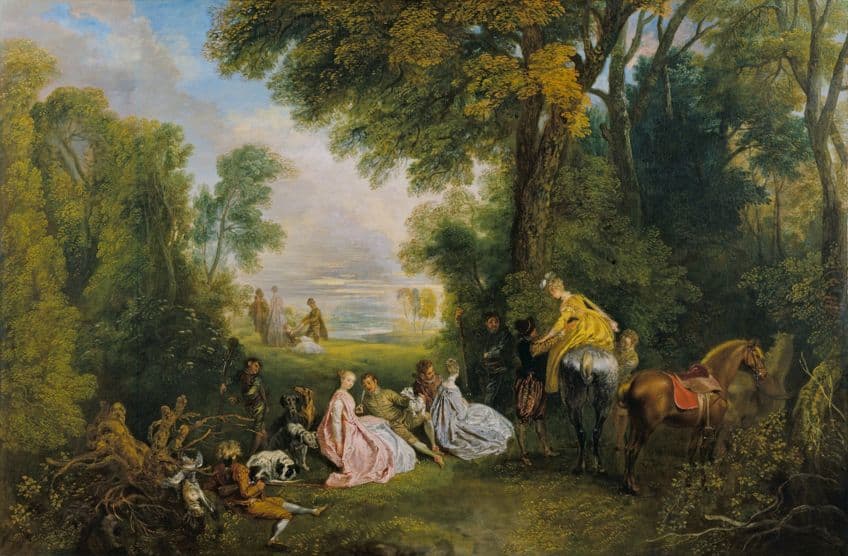
The Influence of the School of Fontainebleau
The School of Fontainebleau was founded by Rosso Florentino, an artist from Italy that was invited by King Francis I in 1530, to produce art for the French court, where he pioneered the French Mannerism style. The style grew popular due to its highly choreographed sense of balance created by all the elements incorporated into the school’s distinctive interior design producing a unified whole.
The Rococo style’s focus on elaborate settings was influenced by Rosso’s pioneering use of gilded and decorative motifs in the stucco reliefs he utilized as frames.
Gilding was one of the Fontainebleau School’s most significant contributions, providing objects with magnificent elegance, such as Salt Cellar (153) by Benevento Cellini. In Rococo interiors, even the most basic elements were adorned and accentuated in this manner, such as the cartel clocks. These were just ordinary clocks that had been embedded within detailed pieces that had a sculptural aesthetic and then gilded to fit into the interior’s overall feel and look.
The Rococo Period of Design
The Rococo style started to emerge in interior design when Jules Hardouin-Mansart, an architect who was commissioned to design the Château de Marly and the private apartments of Louis XIV, collaborated with Pierre Le Pautre, a renowned engraver. The engraver was the first to incorporate c or s-shaped lines on ceilings and walls in the form of arabesques. He was known as a designer of ornaments (ornemaniste in French), a reflection of the significant role that craftsmen and artisans played in helping to develop the decorative Rococo style.

France had grown to become the dominant power in Europe during Louis XIV’s reign, and the people of the country turned their attention toward the pursuit of leisurely activities and personal matters. After his passing in 1715, he was succeeded by the Duc d’ Orléans as the king’s heir, Louis XV was only five years old at the time. Duc d’ Orléans was infamous for his hedonism, and the era in which he reigned was the perfect environment for the Rococo style to flourish. In 1723, Louis XV took the throne and became a significant patron of Rococo architecture.
As France was considered to be Europe’s artistic hub, the other European courts soon started steering in the same stylistic direction.
The Work of Jean-Antoine Watteau
Rococo paintings during this period were pioneered by Jean-Antoine Watteau. He was born in the Belgian village of Valenciennes which had subsequently become French territory, and his early affinity for drawing and art resulted in him becoming an apprentice to a painter who worked locally. He then moved to Paris, making a living by painting copies of Paul Veronese and Titian’s artworks. He subsequently joined the famous decorator Claude Audran’s studio, where he then befriended Claude Gillot, who was renowned for his comedic theater productions. This had a significant influence on Watteau, who embraced this theatrical approach, portraying costumed figures in front of artificially illuminated backdrops. He entered the Prix de Rome competition in 1712, and he was then admitted as one of the academy’s full members. The Rococo period was effectively launched by his artwork Embarkation for Cythera (1717).
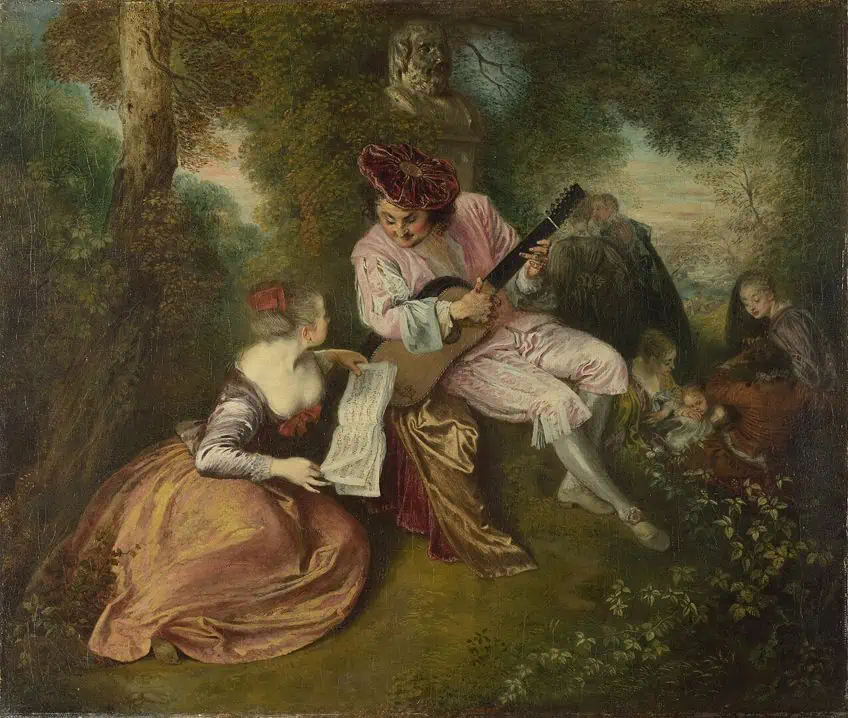
To refer to the artwork, the term Fête Galante was coined by the academy, thereby becoming a prominent aspect of Rococo painting. These Rococo paintings depicted garden parties which were very popular among wealthy aristocrats, featuring people dressed wearing ballroom costumes eating, drinking, and engaging in amorous behavior. Not only were these Rococo paintings appealing to patrons, but also to the academy, which considered historical paintings as the most respected genre.
The Luxembourg Palace’s official keeper was Claude Audren, and while Watteau was working for him there, he copied 24 artworks by Peter Paul Rubens displayed inside the palace which portrayed the Life of Marie de Medici (1622 – 1625). This series combined mythological subjects and allegorical figures with portrayals of the aristocratic courts and the Queen. Rubens was renowned for pioneering the trois crayons technique (three chalks in English), which involved using black, white, and red to produce various coloristic effects.
Watteau managed to also master this technique and was subsequently embraced by succeeding Rococo painters such as François Boucher.
The Work of François Boucher
Starting in 1730 and continuing into the 1760s, François Boucher rose to become one of the most famous Rococo artists of the style’s mature period. Known for his works that combined erotic nudes with refined elegance, he was just as renowned for his tapestry designs, theatrical settings, and decorative arts. His talents were officially acknowledged in 1765 when he was made the king’s first painter, although he was primarily known for his connection to King Louis XV’s mistress, the renowned patron of the arts, Madame de Pompadour. Due to his royal patronage and skill at producing Rococo art, he was regarded as a person who not only expressed but embodied the artistic tastes of the period.
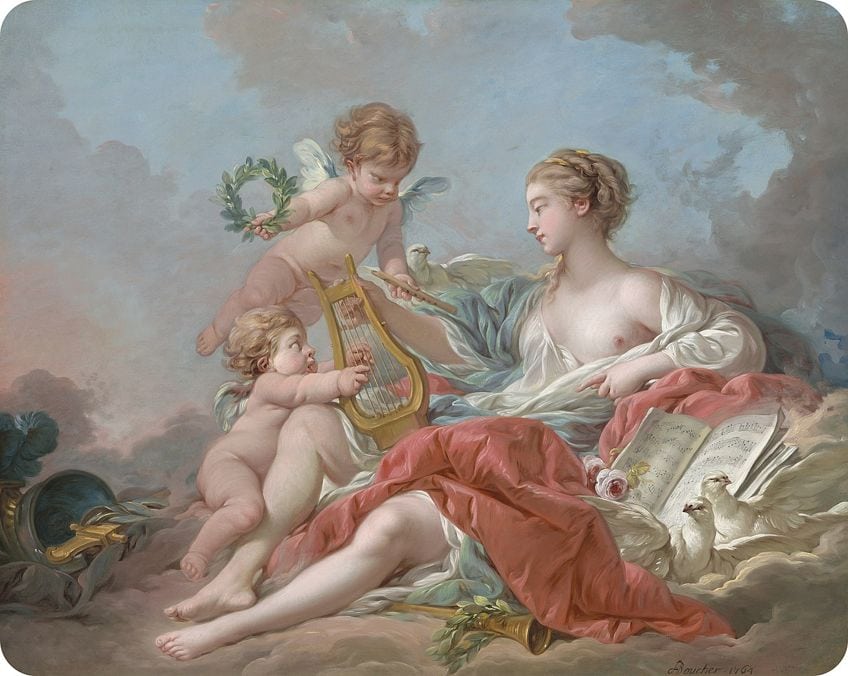
The Patronage of Madame de Pompadour
Owing to her role in helping to establish Paris as Europe’s artistic center and her efforts to promote the style, she is often referred to as the “godmother of Rococo art. She also served as a patron for many artists such as Jean Baptiste Pigalle (a sculptor), Jean-Baptiste Réveillon (a wallpaper designer), and Jacques Guay (a gemstone engraver) thereby influencing other applications of the Rococo style beyond paintings and architecture. De Pompadour continued to be the king’s advisor and confidant until her death from tuberculosis at the age of 42.
Due to her position and work, she is regarded as the epitome of royal patronage.
Rococo Styles
The development of Rococo art largely took place in France. A significant innovation of the time was the invention of the salon – a space that was designed for impressing and entertaining visitors. La Salon de Soubise (1740) by Germain Boffrand and Charles-Joseph Natoire is a well-known example of this type of room.

French Rococo
An airy and light atmosphere was created by the numerous windows, gilded wood, and white walls of the interior. Presented in plate relief and gold stucco, arabesque decorations alluded to garlands, Roman motifs, and cupids. Asymmetrical curves were exaggerated and often based on organic objects such as fronds and seashells. The emphasis on decor rather than architecture would become a hallmark of the Rococo style.
Rococo paintings were very influential on the rest of the French Rococo movement, and its most famous painters had a major influence on every aspect of design from Rococo fashion to tapestries and interiors.
Besides the aforementioned Rococo artists Boucher and Watteau, other notable painters include Jean-Marc Nattier, Jean-Baptiste van Loo, and François Lemoyne. One of the most interesting features of French Rococo artworks is that many of the most notable artist families produced a consistent standard of art in their workshops, such as the Coypels and the Van Loots.

Italian Rococo
Painting dominated Italian Rococo, such as the artworks of the Venetian Rococo artist Tiepolo. Tiepolo’s masterworks were massive altarpieces and frescos that combined the Venetian School’s focus on color with ceiling paintings. He earned several royal contracts throughout Europe, including his collection of ceiling murals at Germany’s Wurzburg Residenz as well as the Apotheosis of the Spanish Monarchy (1766) which is housed in the Royal Palace in Madrid. The Italian Rococo period is especially remembered for its famous landscape Rococo painters, most notably Canaletto.
While producing iconic views of Venice’s splendor and canals, he popularized the use of the two-point linear perspective.
The English aristocrats were great admirers of his artworks such as Venice: Santa Maria Della Salute (c. 1740). It became a tradition that young English nobles go on a European “Grand Tour”, visiting notable places to learn about the classical origins of Western art and civilization. The tours ushered in a new era of aristocratic tourism, with Venice standing out for its hedonistic festive atmosphere and stunning landscapes. These youthful aristocrats were also typically customers and collectors, and the majority of Canaletto’s paintings were sold to an English market, and he relocated to England in 1746 to be accessible to his art market, where he resided for around 10 years.
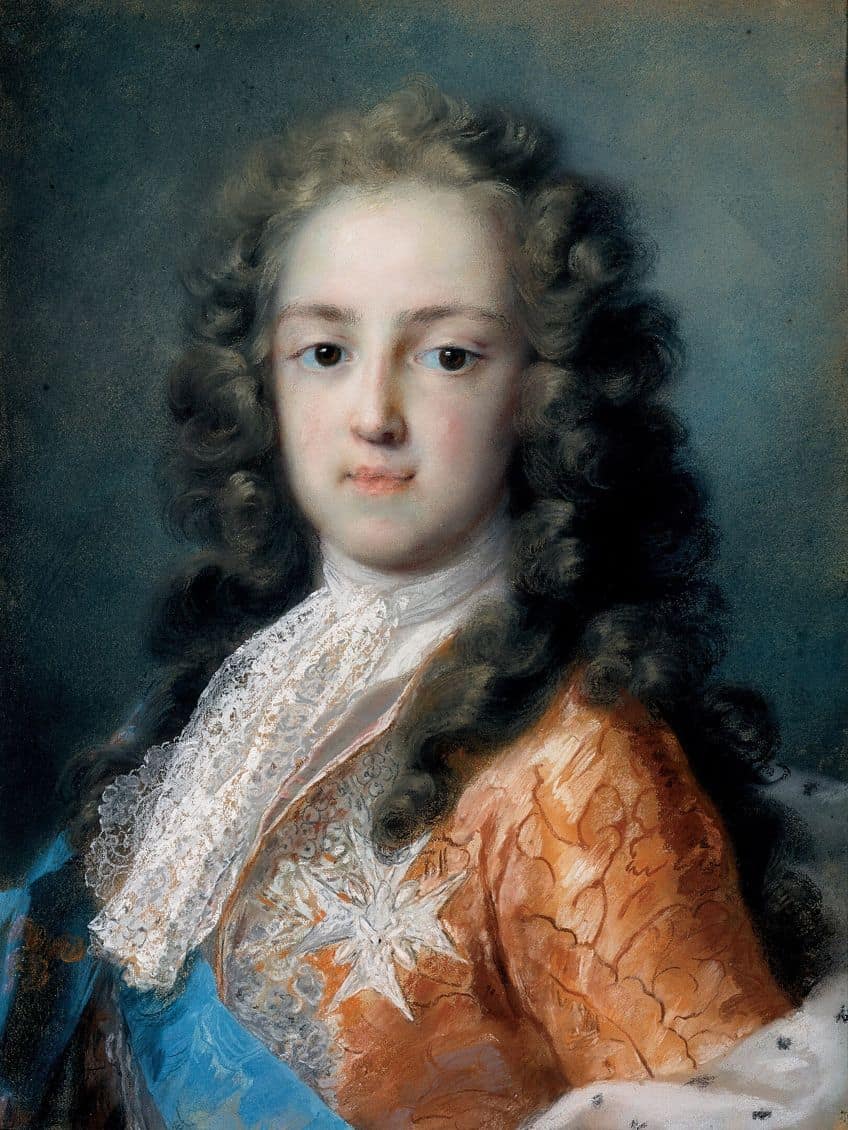
Rosalba Carriera’s allegorical paintings and pastel portraits were sought across Europe, with invitations to the royal courts of Austria, France, and Poland. She revolutionized the use of pastels, which were previously solely used for preliminary sketches, as a material for painting, and produced a larger variety of motions and pre-prepared colors by turning the chalk into sticks. Rosalba Carriera’s Portrait of Louis XV as Dauphin (1721) pioneered the new Rococo portraiture style, stressing aesthetic appeal and artistic value.
Until the 1720s, when Filippo Juvarra designed multiple Northern Italian palaces in the Rococo architecture style, Italy continued to prioritize the Baroque style due to its deep ties to the Catholic church. Juvarras’ masterpiece was the Stupinigi Palace which was located in Turin, which he designed for the King of Sardinia as a hunting lodge. Simultaneously, Rococo interiors gained popularity in Sardinia, Genoa, Venice, and Sicily, where the style developed regionally, especially in furniture design.
The Rococo interiors of Italy were famed for their mirrors and Venetian glass chandeliers, as well as their opulent use of velvet and silk upholstery.
German Rococo
Germany’s Rococo style manifested itself enthusiastically in interior design, architectural masterpieces, and applied arts. The incorporation of bright pastel hues such as lemon, lilac, blue, and pink was a distinctive feature of German Rococo. Hugh Honour, an art historian, praised his Hall of Mirrors at the Amalienburg as epitomizing effortless grace and gossamer refinement. German architects also experimented with different room designs, such as ripping away walls or creating bending walls, and made the positioning of new structures a significant part of the overall appearance, as demonstrated by Melk Abbey which was created by Jacob Prandtauer.
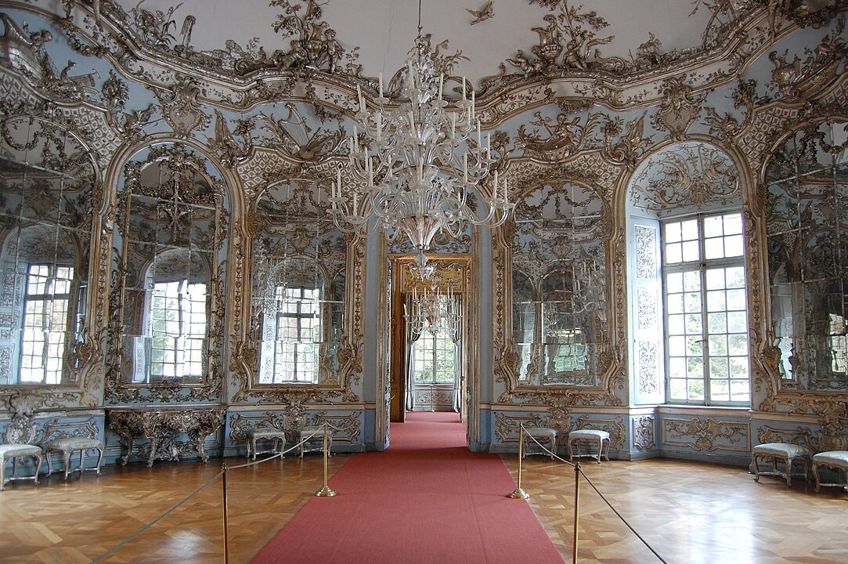
English Rococo
The use of Rococo in England, dubbed “French style”, was more limited, since the style’s extravagances were countered with a sober Protestantism. As a consequence, rocaille was only used occasionally as detailing and for motifs. In approximately 1740, the Rococo aesthetic started to be used in British furnishings, most famously in Thomas Chippendale’s pieces. Chippendale’s Gentleman’s and Cabinet-makers’ Directory (1754), which illustrated Rococo designs, would go on to become an industry standard.
Rococo influenced many British painters, including Thomas Gainsborough, William Hogarth, and the Swiss Angelica Kauffman.
Hogarth pushed for the incorporation of serpentine lines, which he saw as more natural and visually pleasing. Gainsborough started his studies under Gravelot, a former pupil of Boucher, whose airy brushstrokes and color palette pushed the artist’s portraiture toward color and light fluidity. Angelica Kauffman was born in Switzerland but lived the majority of her life in London and Rome. She stayed in London from 1766 until 1781, where the renowned Sir Joshua Reynolds praised her portraits. She was one of only two women admitted to the Royal Academy of Arts in London and was crucial in developing the Rococo style and, later, Neoclassicism.
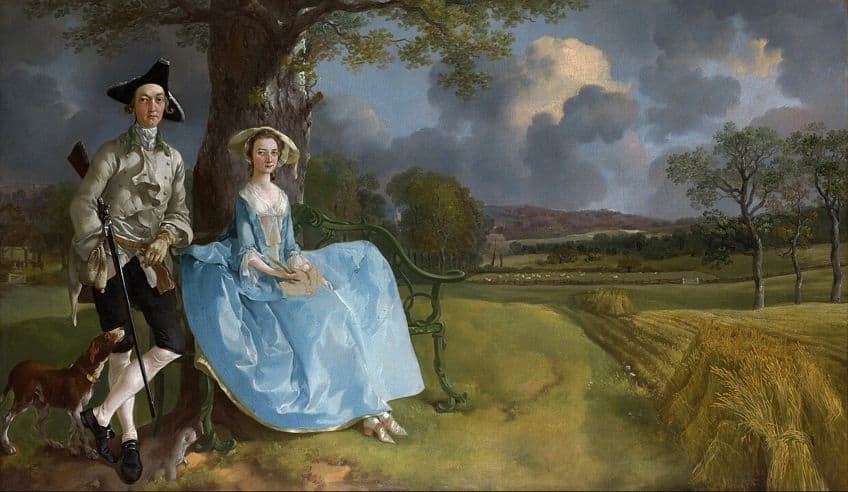
After Rococo
Abel-François Poisson de Vandières, a nephew of Madame de Pompadour, traveled to Italy in 1750 to observe the trends in Italian art and architecture. Vandières was named director of the King’s Buildings after his return whereupon he started to advocate for a Neoclassical style. Notable minds of the time, such as Voltaire the famed philosopher, and Diderot the critic, denounced Rococo as hedonistic and shallow. By 1780, these developments, together with the mounting revolutionary spirit in France, had led the Rococo style to fall out of popularity.
The artist Jacques-Louis David founded the Neoclassicism movement, which valued bravery and moral integrity.
As a consequence, by 1836, it had come to signify something “outdated”, and by 1841, it had come to indicate “distastefully bombastic or excessive”. The negative connotations persisted into the 20th century when the term rococo was employed to describe anything pompous and distasteful in artwork or literature. Rococo art and design would diverge as, amid new trends in the capital, the Rococo style remained popular across the French regions. During King Louis Philippe’s restored monarchy in the 1820s, a resurgence known as the “Second Rococo” style gained prominence and expanded to Bavaria and Britain.
The rebirth was known as Victorian Rococo in England and lasted until roughly 1870, prompting the Rococo Revival in America. However, Rococo painting went out of fashion, with the possible exception of Chardin’s genre paintings, which remained popular and would eventually have a notable influence on Édouard Manet, Paul Cézanne, and Vincent van Gogh. Jean-Honoré Fragonard, a renowned Rococo artist, was rediscovered by Jules and Edmund de Goncourt. He later influenced the Impressionists, particularly Berthe Morisot and Pierre-Auguste Renoir, as well as current artists such as Kent Monkman, Yinka Shonibare, and Lisa Yuskavage.
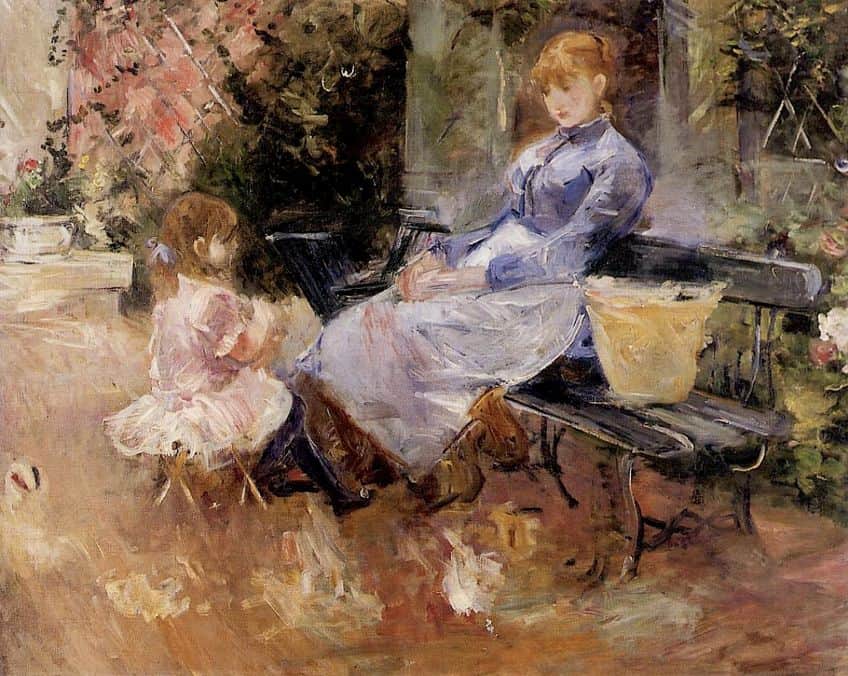
Watteau’s subjects impacted artists such as Paul Cézanne, Pablo Picasso, and Henri Matisse, as well as writers such as Guillaume Apollinaire and Paul Verlaine, choreographer George Balanchine, and Arnold Schoenberg the composer. Rococo and the creatives affiliated with it were only seriously re-evaluated in the late 20th century, when Pop Art movements and the artworks of artists such as Kehinde Wiley, Damien Hirst, and Jeff Koons established a new framework for art conveying the same stylistic, opulent, and fanciful treatments. The trend has also survived in pop culture, as evidenced by the famous song Rococo (2010) by Arcade Fire.
Notable Rococo Artworks
Rococo art usually portrays intimate yet joyful themes of romance, life, and nature, and regularly uses trompe l’oeil to evoke a theatrical and playful mood. It is characterized by an opulent and ornate style, with a focus on decorative details and whimsical motifs. Rococo paintings were fashionable among the period’s aristocracy and were regularly commissioned for salons, bedrooms, and dining rooms. Rococo art, therefore, had a significant influence on the interior design and decorative arts of the 18th century.
The Rococo style had a long-lasting impact on European art in general, influencing succeeding movements such as Art Nouveau and Romanticism. Here are a few of the most notable Rococo paintings.
The Embarkation for Cythera (1717) by Jean-Antoine Watteau
| Artist | Jean-Antoine Watteau (1684 – 1721) |
| Date Completed | 1717 |
| Medium | Oil on canvas |
| Dimensions (cm) | 129 x 194 |
| Location | Musée du Louvre, Paris, France |
This famous Rococo artwork features several passionate lovers clothed in fine aristocratic costume in an idyllic pastoral landscape on Cythera, the mythological island where the goddess of love, Venus, arose from the sea. The poses and gestures are expressive, as the person standing just below the middle of the painting, with his arm around the lady beside him, while she glances back to look at the other couples seated on the ground. On the right, a naked Venus statue arises from a flower-adorned pedestal, as though overseeing the celebrations.
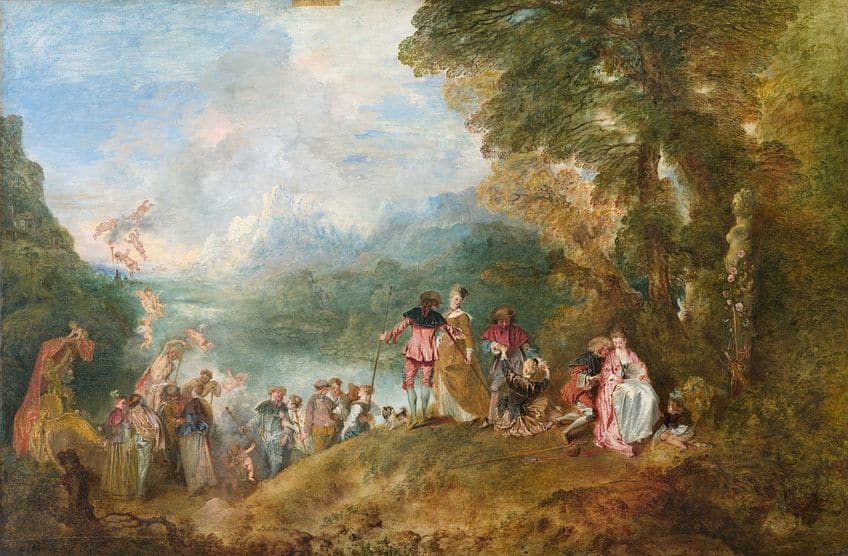
Throughout the piece, naked cherubs can be seen soaring toward the sky or coming between the couples and urging them on. His characters are not so much identifiable people as aristocratic types with smooth powdered features who collectively produce a kind of pleasure and color choreography. With this painting, Watteau created the first Fête Galante and effectively established the start of the Rococo movement.
“Watteau’s paintings are wonderfully poised between the moments immediately before and the moments just after – the individuals he depicts are busy portraying not one but multiple potential situations”, observed Holly Brubach, the art critic.
The Entrance to the Grand Canal (c. 1730) by Canaletto
| Artist | Canaletto (1697 – 1768) |
| Date Completed | c. 1730 |
| Medium | Oil on canvas |
| Dimensions (cm) | 49 x 73 |
| Location | Museum of Fine Arts, Houston, Texas, United States |
This well-known painting portrays the Grand Canal entry in Venice, with several gondoliers moving horizontally over the surface. As three gondolas rise upward in the middle, drawing the viewer’s attention to the horizon, their asymmetrical arrangement produces movement, which is enhanced by the perspective of the church on the left and buildings on the right. The painting has a golden tint and a feeling of the idyllic life of the era, which was inspired by the Venetian school’s love of Arcadian scenery, which strongly influenced the Rococo style.

Canaletto was regarded as a leader in painting from life and portraying the atmospheric qualities at a certain time of the day, which some scholars believe anticipated Impressionism. At the same time, his unique use of topography, which allowed him to represent a location with scientific accuracy, inspired succeeding painters. Venice was a popular destination on the Grand Tour for English aristocracy, and the majority of Canaletto’s artwork was sold to this market.
Owen Swiny, a British art dealer, advised him to paint postcard-sized, topographical landscapes to sell to travelers, and Joseph Smith, an art collector, became a significant patron, selling many of his paintings to King George III.
Soap Bubbles (1734) by Jean-Baptiste Simeon Chardin
| Artist | Jean-Baptiste Simeon Chardin (1699 – 1779) |
| Date Completed | 1734 |
| Medium | Oil on canvas |
| Dimensions (cm) | 61 × 63 |
| Location | The Metropolitan Museum of Art, New York City, United States |
This artwork features two children having fun. Bending forward, an older boy blows through a reed, creating a soap bubble. A smaller boy in the shadows on the right, wearing a plume-adorned hat, peeks over the ledge, his attention fixated on the iridescent bubble. The subdued color choice of deep black and brown accentuates the contrasted brightness and rosy hue of the boy’s face and hands making the observer aware of how absorbed they are in the moment. Tactile textures of skin, fabric, and stone are conveyed through the thickly applied paint of the impasto technique.
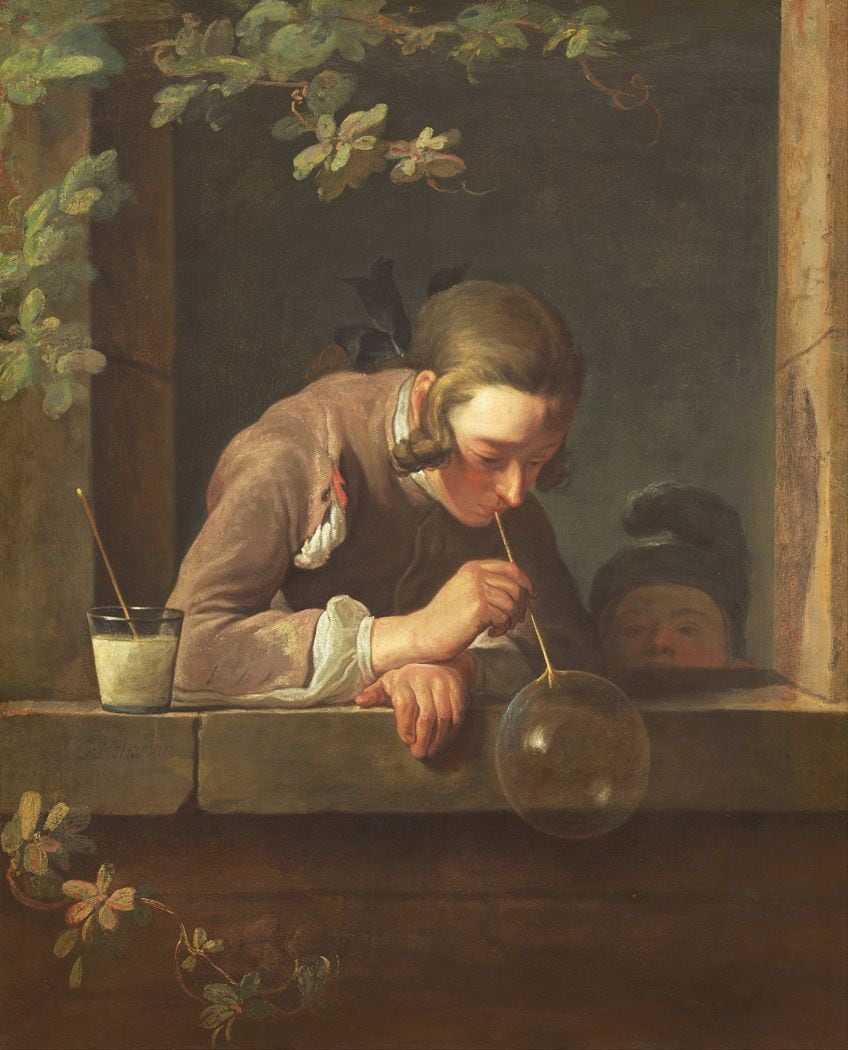
The piece evokes a sense of childlike innocence that is centered on a fleeting pleasure, while simultaneously being elusive since the bubble would have been recognized by the artist’s peers as a reminder of life’s impermanence. Chardin’s realistic genre paintings, inspired by Dutch Golden Age genre artists, were his one-of-a-kind addition to the Rococo style. Unlike other painters who portrayed the nobility and its pastimes, he portrayed household scenes, youngsters at play, and still lives.
All of these reflected Rococo’s adoration for leisurely pleasures.
La Toilette de Vénus (1751) by François Boucher
| Artist | François Boucher (1703 – 1770) |
| Date Completed | 1751 |
| Medium | Oil on canvas |
| Dimensions (cm) | 108 x 85 |
| Location | The Metropolitan Museum of Art, New York City, United States |
This portrait portrays a naked Madame de Pompadour as Venus, accompanied by three angelic cherubs and a couple of white doves. She is seated on a chaise lounge, the back of which is framed with gold rocaille and crowned with a sculpture of a reclined cherub. Blue curtains, vibrant with shadow and light open to a view of a stunning garden, framing the picture with a peaceful ambiance. The figurative treatment is stylized, almost as if airbrushed, while the background is elaborately detailed and ornate, resulting in an impression that reflects the idea of luxury itself. Boucher’s sensuous representations of the era’s prominent individuals, social figures, and pastimes altered the Rococo period, establishing his own unique pictorial identity.
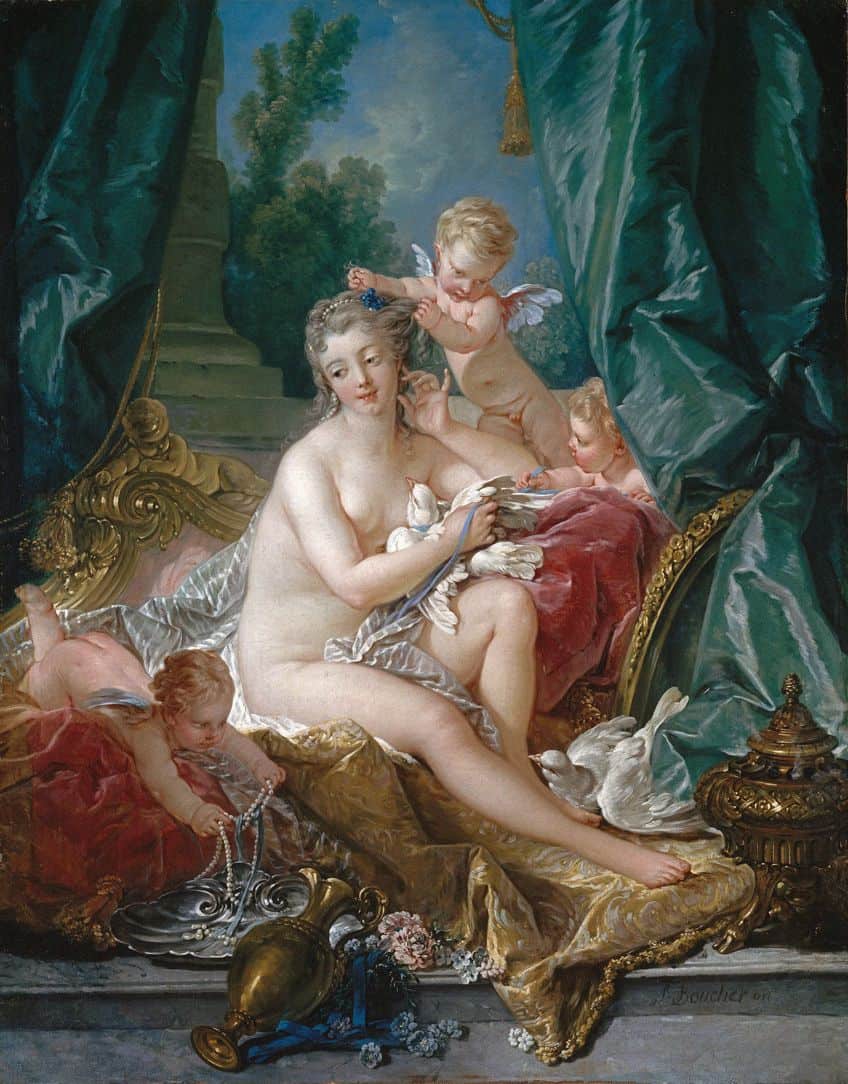
Madame de Pompadour, a genuine “who’s who” of the period, hired Boucher to produce this piece for the Chateau de Bellevues’ private dressing room. “Boucher’s portraits frequently demonstrated a love for what we may call the art of appearances and a knowledge of that art as a tool for fashioning and portraying identity”, wrote one historian. Within just a few decades, the Neoclassicism movement rejected Boucher’s art for the same reasons that had made it so successful among the aristocracy. Art historians such as Jed Perl and Melissa Lee Hyde have just lately started to re-evaluate his oeuvre, while modern artists Lisa Yuskavage and John Currin have acknowledged Boucher as a direct inspiration.
Rococo art initially emerged in France and extended across Europe, influencing architecture, design, and the visual arts. The Rococo style is noted for its whimsical and joyous representations of themes from nature as well as everyday life, usually with a focus on sensuality and leisure. While the Neoclassical movement that followed eschewed the highly ornate elements of the Rococo style, there were many other subsequent contemporary styles that owed much of their aesthetic to the Rococo period.
Frequently Asked Questions?
Was Is the Difference Between Baroque vs. Rococo Art?
The biggest distinction between the two styles is how they address ornamentation and subject matter. Large and dramatic, Baroque art is distinguished by striking lighting, strong curves, and powerful emotions. Baroque art was used to generate awe-inspiring and religious propaganda, and it typically includes scenes from the Bible or saints’ lives. On the other hand, Rococo art is far more joyful and whimsical. It has elaborate details, pastel hues, and playful subjects like romantic love and laid-back pastimes.
What Were the Characteristics of Rococo Fashion?
Rococo fashion was distinguished by loose-fitting, flowing clothing that accentuated the body’s inherent contours. Women’s outfits were often fashioned of lightweight materials with billowing skirts from the waist. Intricate detailing and ornamentation, including lace, ribbons, bows, and needlework, characterized Rococo fashion. These accents were frequently employed to draw attention to a garment’s sleeves, neckline, and hemline. High heels were common in women’s shoes throughout the Rococo period, which helped extend the legs and produce a more elegant stance. Both women and men wore wigs, which were typically powdered and shaped in complex sculptural designs.
Who Were Some of the Most Well-Known Rococo Artists?
One of the most notable artists from the Rococo period was Jean-Antoine Watteau. François Boucher was another renowned figure who was popular because of his allegorical and mythological scenes. Another well-known Rococo artist is Canaletto. Unlike the other artists mentioned above, he was not French but came from Italy. He is most known for his landscapes.
Jordan Anthony is a Cape Town-based film photographer, curator, and arts writer. She holds a Bachelor of Art in Fine Arts from the University of the Witwatersrand, Johannesburg, where she explored themes like healing, identity, dreams, and intuitive creation in her Contemporary art practice. Jordan has collaborated with various local art institutions, including the KZNSA Gallery in Durban, the Turbine Art Fair, and the Wits Art Museum. Her photography focuses on abstract color manipulations, portraiture, candid shots, and urban landscapes. She’s intrigued by philosophy, memory, and esotericism, drawing inspiration from Surrealism, Fluxus, and ancient civilizations, as well as childhood influences and found objects. Jordan is working for artfilemagazine since 2022 and writes blog posts about art history and photography.
Learn more about Jordan Anthony and about us.
Cite this Article
Jordan, Anthony, “Rococo Art – The Romantic Drama of This French Art Period.” artfilemagazine – Your Online Art Source. October 17, 2023. URL: https://artfilemagazine.com/rococo-art/
Anthony, J. (2023, 17 October). Rococo Art – The Romantic Drama of This French Art Period. artfilemagazine – Your Online Art Source. https://artfilemagazine.com/rococo-art/
Anthony, Jordan. “Rococo Art – The Romantic Drama of This French Art Period.” artfilemagazine – Your Online Art Source, October 17, 2023. https://artfilemagazine.com/rococo-art/.



